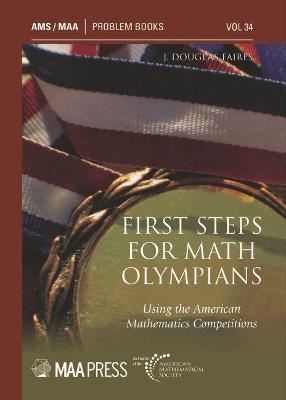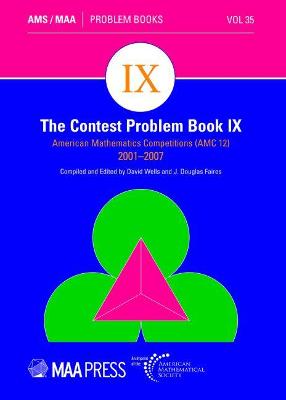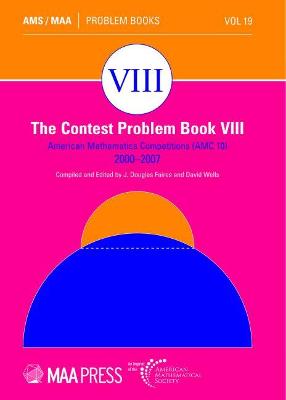Problem Books
3 total works
Any high school student preparing for the American Mathematics Competitions should get their hands on a copy of this book! A major aspect of mathematical training and its benefit to society is the ability to use logic to solve problems. The American Mathematics Competitions (AMC) have been given for more than fifty years to millions of high school students. This book considers the basic ideas behind the solutions to the majority of these problems, and presents examples and exercises from past exams to illustrate the concepts. Anyone taking the AMC exams or helping students prepare for them will find many useful ideas here. But people generally interested in logical problem solving should also find the problems and their solutions interesting. This book will promote interest in mathematics by providing students with the tools to attack problems that occur on mathematical problem-solving exams, and specifically to level the playing field for those who do not have access to the enrichment programs that are common at the top academic high schools. The book can be used either for self-study or to give people who want to help students prepare for mathematics exams easy access to topic-oriented material and samples of problems based on that material. This is useful for teachers who want to hold special sessions for students, but it is equally valuable for parents who have children with mathematical interest and ability. As students' problem solving abilities improve, they will be able to comprehend more difficult concepts requiring greater mathematical ingenuity. They will be taking their first steps towards becoming math Olympians!
This is the ninth book of problems and solutions from the American Mathematics Competitions (AMC) contests. It chronicles 325 problems from the thirteen AMC 12 contests given in the years between 2001 and 2007. The authors were the joint directors of the AMC 12 and the AMC 10 competitions during that period.
The problems have all been edited to ensure that they conform to the current style of the AMC 12 competitions. Graphs and figures have been redrawn to make them more consistent in form and style, and the solutions to the problems have been both edited and supplemented. A problem index at the back of the book classifies the problems into subject areas of Algebra, Arithmetic, Complex Numbers, Counting, Functions, Geometry, Graphs, Logarithms, Logic, Number Theory, Polynomials, Probability, Sequences, Statistics, and Trigonometry. A problem that uses a combination of these areas is listed multiple times.
The problems on these contests are posed by members of the mathematical community in the hope that all secondary school students will have an opportunity to participate in problem-solving and an enriching mathematical experience.
The problems have all been edited to ensure that they conform to the current style of the AMC 12 competitions. Graphs and figures have been redrawn to make them more consistent in form and style, and the solutions to the problems have been both edited and supplemented. A problem index at the back of the book classifies the problems into subject areas of Algebra, Arithmetic, Complex Numbers, Counting, Functions, Geometry, Graphs, Logarithms, Logic, Number Theory, Polynomials, Probability, Sequences, Statistics, and Trigonometry. A problem that uses a combination of these areas is listed multiple times.
The problems on these contests are posed by members of the mathematical community in the hope that all secondary school students will have an opportunity to participate in problem-solving and an enriching mathematical experience.
For more than 50 years, the Mathematical Association of America has been engaged in the construction and administration of challenging contests for students in American and Canadian high schools. The problems for these contests are constructed in the hope that all high school students interested in mathematics will have the opportunity to participate in the contests and will find the experience mathematically enriching. These contests are intended for students at all levels, from the average student at a typical school who enjoys mathematics to the very best students at the most special school. In the year 2000, the Mathematical Association of America initiated the American Mathematics Competitions 10 (AMC 10) for students up to grade 10.
The Contest Problem Book VIII is the first collection of problems from that competition covering the years 2001-2007. J. Douglas Faires and David Wells were the joint directors of the AMC 10 and AMC 12 during that period, and have assembled this book of problems and solutions. There are 350 problems from the first 14 contests included in this collection. A Problem Index at the back of the book classifies the problems into the following major subject areas: Algebra and Arithmetic, Sequences and Series, Triangle Geometry, Circle Geometry, Quadrilateral Geometry, Polygon Geometry, Counting Coordinate Geometry, Solid Geometry, Discrete Probability, Statistics, Number Theory, and Logic.
The major subject areas are then broken down into subcategories for ease of reference. The problems are cross-referenced when they represent several subject areas.
The Contest Problem Book VIII is the first collection of problems from that competition covering the years 2001-2007. J. Douglas Faires and David Wells were the joint directors of the AMC 10 and AMC 12 during that period, and have assembled this book of problems and solutions. There are 350 problems from the first 14 contests included in this collection. A Problem Index at the back of the book classifies the problems into the following major subject areas: Algebra and Arithmetic, Sequences and Series, Triangle Geometry, Circle Geometry, Quadrilateral Geometry, Polygon Geometry, Counting Coordinate Geometry, Solid Geometry, Discrete Probability, Statistics, Number Theory, and Logic.
The major subject areas are then broken down into subcategories for ease of reference. The problems are cross-referenced when they represent several subject areas.


